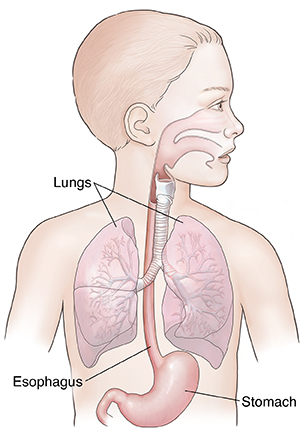Dysphagia is trouble swallowing. Your child may choke when eating or drinking. This problem can be short-term from a throat infection or other problem in the throat. Other problems can cause it to go on for a longer time. In this case, dysphagia can make it hard for your child to get enough nutrients to grow. Your child also may breathe food into their lungs (aspirate). This can cause serious lung infections, such as pneumonia.
A child with dysphagia may have symptoms that include:
-
Arching or stiffening of the body during feedings.
-
A wet or raspy voice during or after eating.
-
Choking or coughing during or right after eating or drinking.
-
Drooling.
-
Food or liquids coming out of the nose or mouth during or after feeding.
-
Gagging.
-
Crankiness, crying, or lack of alertness during feedings.
-
Slow eating.
-
Swallowing a single mouthful of food several times.
-
Trouble coordinating sucking and swallowing.
-
Vomiting after eating or drinking.
Dysphagia often affects children who are just learning to eat solid foods. In this case, it should go away as a child gets used to eating. Tests may be done to see if there is another cause, such as problems with the mouth, tongue, or throat. The tube that carries food from the mouth to the stomach (esophagus) may be examined for problems. Certain problems with the muscles or nerves can also cause swallowing issues. Your child’s doctor can discuss the cause of the dysphagia with you.
Dysphagia can be treated in different ways depending on the cause. Certain medicines may help. In some cases, a speech therapist can help your child learn to control muscles in the mouth, tongue, and throat. If there is a structural problem with the mouth, throat, or esophagus, your child’s doctor can outline treatment choices.
Home care
To help reduce or ease your child’s symptoms:
-
Give your child any medicines exactly as directed. Ask the doctor for advice if your child has a hard time swallowing the medicine.
-
Try feeding thick liquids instead of thin liquids. Add a small amount of rice cereal to infant formula or pumped breast milk to thicken it. Blend the mixture before putting it in a baby bottle. Don't cut holes in bottle nipples, since this can increase the risk of choking and aspiration and interfere with oral development. Future feeding and speech skills may be affected.
-
Don't give baby foods from a spoon until your child is 4 months old.
-
Vary the taste, texture, and temperature of soft foods for children older than 4 months.
-
Make sure your child stays upright for at least an hour after eating.
-
Provide safe toys and other objects for your baby to chew on.
Follow-up care
Follow up with your child’s doctor as advised. They can give you information about tests your child may need.
When to get medical advice
Contact your child's doctor if:
-
Your child can’t keep down food or liquid.
-
Your child’s symptoms get worse quickly.
-
Your child keeps losing weight.
-
You notice any other symptoms as advised by your child’s doctor.
Call 911
Get your child emergency medical care if:
-
Your child has trouble breathing.
-
Your child faints (loses consciousness).
-
Your child’s skin or lips turn blue.
Featured in
Author: Wheeler, Brooke
© 2000-2025 The StayWell Company, LLC. All rights reserved. This information is not intended as a substitute for professional medical care. Always follow your healthcare professional's instructions.

